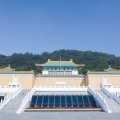NATIONAL PALACE MUSEUM
If there were only one place to visit in Taiwan, it would probably be this one. Five thousand years of Chinese civilization are preserved in this sanctuary of art that is the National Palace Museum. On the hillside, the building seems to go into the rock, so much so that the Taiwanese say they have hidden their national treasures in bomb shelters dug into the mountain... And every joke has a basis in truth, since only 15,000 items from the collection, which comprises 650,000 pieces - twice the Louvre's heritage - are on display. The rest is carefully kept in galleries dug in the mountain, sheltered, in air-conditioned chambers! To appreciate the museum and its porcelains, bronzes, pottery, objects of worship, clothing, paintings, partitioned, it is necessary to count at least one day of visit. Some guides are French-speaking, ask at the reception desk. After the visit, the small Chih Shan Park, below the main museum building (on the left), is a pleasant place to relax, and the wooden buildings that adorn it are particularly successful.
The palace treasures odyssey. The history of this collection is epic, full of twists and turns. It is a miracle that some parts were not damaged, looted or misplaced. The gigantic collection began at the beginning of the Song Dynasty (960-1279). Emperor Tai-Zu, a fervent supporter and lover of the arts, founded the Hanlin Academy to encourage Chinese talent. His brother, Emperor Tai-Zong, extended his elder's design by donating conservation galleries, including the Imperial Gallery, containing rare books, calligraphy and paintings, to the collection. This gallery became the museum of the North Song Palace; it was transported to Nanking under the Ming and only returned to Beijing under the Qing (1644-1911). This long dynasty was marked by emperors who were passionate about art and who strove to centralize all the wonders of their country, especially Qianlong who reigned from 1736 to 1795. The collection of the National Palace Museum is therefore mainly made up of imperial collections from this dynasty, the last in China.
In 1924, the nationalists entered the Forbidden City and expelled Pu-Yi and his court. A team of experts in art history was then asked to draw up an inventory of the imperial collection. It takes these specialists seven years to list all the treasures. In the meantime, in 1925, the nationalists founded the National Palace in Beijing, where some of the pieces are exhibited. In 1931, the Japanese took control of Manchuria and threatened Beijing. To prevent the collection from falling into the hands of the invader, the works of art are carefully packed in more than 20,000 crates. This is the beginning of a long journey: they will be moved, lugged, shaken, for more than fifteen years and over 12,000 km. Initially transferred to Nanking, the collection headed west when the Japanese threatened the South. In 1935, the collection was partially shown to Westerners in London, and some feared that the English would take advantage of the uncertainty of the situation not to return the objects. But this exhibition resonates, in Europe, as a final tribute to the great Chinese civilization under attack on all fronts and which is close to breaking apart. In 1948, during the debacle, before the communists took control of the country, the collection was disbanded, and only 4,800 cases were shipped to Taiwan. They are stored in Taichung, in the centre of the island, and are only shown to the public from 1965 onwards in the relocated National Palace Museum. Some of these masterpieces that have been handed down over the last seven thousand years are going abroad: in 1991 and 1996, for a travelling exhibition in the United States and in Paris, in 1998, in the national galleries of the Grand Palais for an exhibition called "Treasures of the National Palace Museum, Taipei, Memory of Empire". The exhibited collections are rotated approximately every two or three months.
More than just an art museum, the National Palace Museum is a true guardian of Chinese cultural heritage. As an example, it offers expertise on Chinese artworks, and works closely with the most famous specialists in Chinese history and art, constantly expanding the collection, and providing new information about the pieces on display or in reserve.
The collections. It is impossible to describe the works on display in real time, as they may have been replaced in the meantime. However, the museum is committed to presenting collections that are representative of Chinese culture in all its diversity. Thus, from Neolithic pieces (including magnificent jades and bronzes) to more recent objects (including those belonging to the emperors of the Ming and Qing dynasties), including Tang ceramics and Song paintings. In general, the 3 floors of the museum are divided into two parts, each exhibiting a particular art. And we can understand why mainland China is so jealous of this unique collection...


Bon rapport qualité prix.
Une poste avec 2 employés est disponible dans le hall d'entrée , à côté de l'immense boutique du musée proposant des cadeaux souvent peu chers et de bons gouts. Incontournable !
par contre choisir son horaires car il y a plein de monde et donc du bruit .
Accès facile depuis la station de metro en bus . je l est fait a pied meme.
grande boutique et cafe mais plein.
Il y a parfois beaucoup de monde mais dans les salles on circule facilement
A ne pas rater
Magnifique et varié.